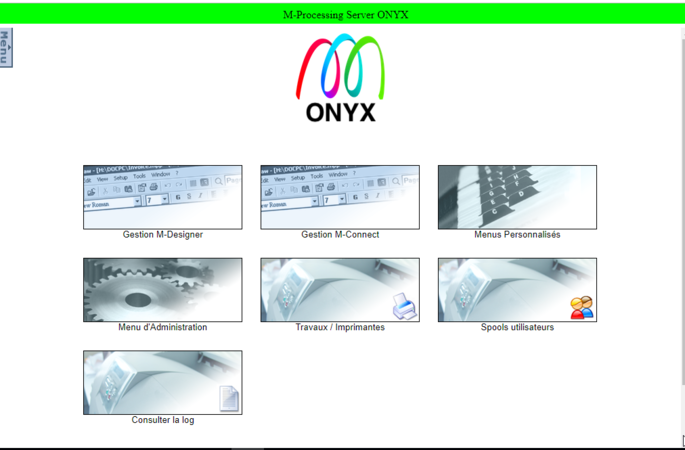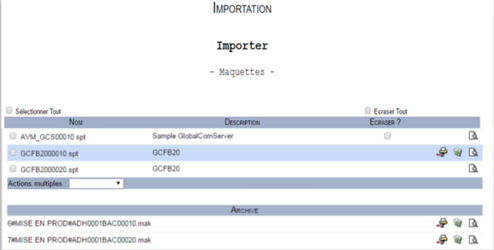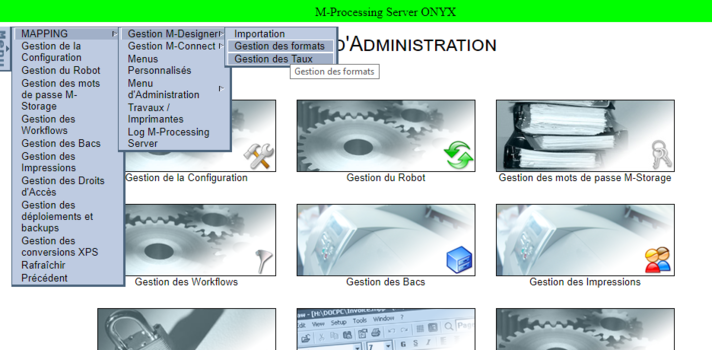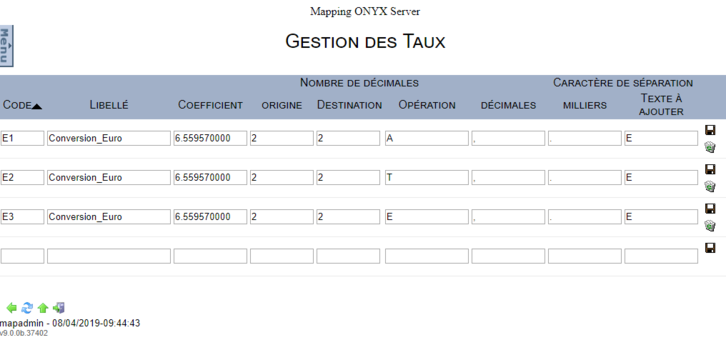ONYX - 9.0 - Utilisation - Gestion Designer/en
Différence entre versions
(Page créée avec « Designer is a module of the Onyx Server Suite which allows you to format graphic documents. Document templates are designed and generated from the Designer application set... ») |
|||
| (44 révisions intermédiaires par 2 utilisateurs non affichées) | |||
| Ligne 9 : | Ligne 9 : | ||
| − | == | + | ==Importing templates== |
[[Fichier:OX S DESIGNER IMPRT.png|centré|sans_cadre|702x702px]] | [[Fichier:OX S DESIGNER IMPRT.png|centré|sans_cadre|702x702px]] | ||
| − | + | A document which was generated from the Designer application cannot be used directly on the production server. This document needs to be imported into Onyx Server beforehand. | |
| − | === | + | ===Import view=== |
| − | + | The import interface is divided in two parts: the templates generated with Designer in the first part, and the templates which were exported from an other Onyx Server engine in the second part (called Archives). | |
| Ligne 25 : | Ligne 25 : | ||
| − | + | In the example above: | |
| − | * | + | *Three templates were generated from Designer and are ready for import: AVM_GCS format sequence 10, GCFB20 format sequences 10 and 20 |
| − | * | + | *Two templates were exported from an other Onyx Server instance: ADH001BAC formats sequences 10 and 20. |
===Actions=== | ===Actions=== | ||
| − | + | Three actions are available for each of the previously listed templates: | |
| − | * | + | *Import template: imports the structure of the template in the server file path. The format which has been imported can then be used in the production environment, in the engine. |
| − | * | + | *Delete template: deletes the template structures without importing them. If this format was already placed in the production environment in the server, it is not edited. |
| − | * | + | *View template details: opens a window to see the objects and resources which make up the template. |
| − | === | + | ===Overwriting=== |
| − | + | In the case of Designer originated templates, when a generated template corresponds to a format which is already available on the production environment on the server, the Overwrite box appears. By ticking this box, the user forces the template to be imported, the existing format is then overwritten with the latest edits generated. | |
| − | + | When it comes to archives, however, roll-outs are done. The latter are considered as intended and mastered. Importing a format which was subject to a roll-out then systematically overwrites the format which is already on the server. | |
| − | ===Actions | + | ===Multiple Actions=== |
| − | + | The buttons which can be found on every detail line order the corresponding templates to carry out unitary and local actions. | |
| − | + | When several document templates are generated from Designer, using a multiple action can be interesting to import or delete several templates at once. | |
| − | + | A multiple action is used to include one or several templates in an action, with templates being selected using the boxes at the beginning of the lines. The list of suggested choices allows you to control the action to carry out on the selection: import or delete as well as overwrite if selected. | |
| − | == | + | ==Managing formats== |
[[Fichier:OX S g format.png|centré|sans_cadre|712x712px]] | [[Fichier:OX S g format.png|centré|sans_cadre|712x712px]] | ||
| − | + | This interface lists all the formats on the production environment, on the server. The list is sorted according to the alphabetical order of generation languages. | |
| − | + | The information the user is provided with in this view respectively include: | |
| − | - | + | - Language = generation language of the format (always XPS); |
| − | - Format = | + | - Format = name of the format in the Designer application; |
| − | - | + | - Sequence = sequence number defined in the Designer application; |
| − | - Description = description | + | - Description = description associated with the format in the Designer application; |
| − | - Date = date | + | - Date = date of the last import on the server. |
| − | == | + | ==Managing conversion rates== |
| − | + | This interface allows you to declare, configure and manage the different conversion rates which can be used with Designer formats. | |
| − | + | This feature was initially designed to convert the different currencies in euro (€) as the single currency was introduced in most est European countries in 2002. It can also be used to format amounts to change thousand and decimal delimiters for example. | |
| − | === | + | ===Defining conversion rates in Onyx Server=== |
| − | + | The solution is pre-configured with three conversion rates which are already declared: | |
| Ligne 79 : | Ligne 79 : | ||
| − | + | Up to five conversion rates can be declared and used in Designer templates and each rate can be edited or deleted. | |
| − | + | The settings for a rate include: | |
| − | *Identification : | + | *Identification: |
| − | - Code : | + | - Code: from E1 to E9 and from EA to EZ, respectively corresponding to the 35 values possible in the properties of a Conversion type zone in Designer, |
| − | - | + | -Description: name or description of the rate (this information is only aimed at the user). |
| − | * | + | *Conversion: |
| − | - Coefficient : coefficient ( | + | - Coefficient: coefficient (up to 9 decimals) applied to the values to convert, |
| − | - | + | - Origin: number of decimals to take into account for the original values to convert, |
| − | - Destination : | + | - Destination: number of decimals to retrieve for the values converted, |
| − | - | + | - Operation: operation to apply on values to convert: A for a multiplication, E for a division and T to truncate. |
| − | * | + | *Formatting the result: |
| − | - | + | - Decimals: character to print as decimal delimiter: "," or "." or (space). Use "#" so no delimiter is added, |
| − | - | + | - Thousands: character to print as thousand delimiter: "," or "." or (space). Use "#" so no delimiter is added, |
| − | - | + | - Text to add: optional string to print after the converted value. |
| − | === | + | ===Use in Designer=== |
| − | + | In the Designer application, the rates are used by Conversion type zones, the sub-type being used to select the number of the rate to apply, as can be seen below: | |
<br /> | <br /> | ||
[[Fichier:OX S DESIGNER taux emple.png|centré|sans_cadre|600x600px|alt=]] | [[Fichier:OX S DESIGNER taux emple.png|centré|sans_cadre|600x600px|alt=]] | ||
<br /> | <br /> | ||
Version actuelle datée du 28 août 2019 à 12:42
Sommaire
Introduction
Designer is a module of the Onyx Server Suite which allows you to format graphic documents. Document templates are designed and generated from the Designer application set up on the user workstations onto the Onyx Server production server. It is possible to import and manage document templates as well as the resources associated to them on the server from the Designer Management screen.
Importing templates
A document which was generated from the Designer application cannot be used directly on the production server. This document needs to be imported into Onyx Server beforehand.
Import view
The import interface is divided in two parts: the templates generated with Designer in the first part, and the templates which were exported from an other Onyx Server engine in the second part (called Archives).
In the example above:
- Three templates were generated from Designer and are ready for import: AVM_GCS format sequence 10, GCFB20 format sequences 10 and 20
- Two templates were exported from an other Onyx Server instance: ADH001BAC formats sequences 10 and 20.
Actions
Three actions are available for each of the previously listed templates:
- Import template: imports the structure of the template in the server file path. The format which has been imported can then be used in the production environment, in the engine.
- Delete template: deletes the template structures without importing them. If this format was already placed in the production environment in the server, it is not edited.
- View template details: opens a window to see the objects and resources which make up the template.
Overwriting
In the case of Designer originated templates, when a generated template corresponds to a format which is already available on the production environment on the server, the Overwrite box appears. By ticking this box, the user forces the template to be imported, the existing format is then overwritten with the latest edits generated. When it comes to archives, however, roll-outs are done. The latter are considered as intended and mastered. Importing a format which was subject to a roll-out then systematically overwrites the format which is already on the server.
Multiple Actions
The buttons which can be found on every detail line order the corresponding templates to carry out unitary and local actions. When several document templates are generated from Designer, using a multiple action can be interesting to import or delete several templates at once. A multiple action is used to include one or several templates in an action, with templates being selected using the boxes at the beginning of the lines. The list of suggested choices allows you to control the action to carry out on the selection: import or delete as well as overwrite if selected.
Managing formats
This interface lists all the formats on the production environment, on the server. The list is sorted according to the alphabetical order of generation languages.
The information the user is provided with in this view respectively include: - Language = generation language of the format (always XPS);
- Format = name of the format in the Designer application;
- Sequence = sequence number defined in the Designer application;
- Description = description associated with the format in the Designer application;
- Date = date of the last import on the server.
Managing conversion rates
This interface allows you to declare, configure and manage the different conversion rates which can be used with Designer formats. This feature was initially designed to convert the different currencies in euro (€) as the single currency was introduced in most est European countries in 2002. It can also be used to format amounts to change thousand and decimal delimiters for example.
Defining conversion rates in Onyx Server
The solution is pre-configured with three conversion rates which are already declared:
Up to five conversion rates can be declared and used in Designer templates and each rate can be edited or deleted.
The settings for a rate include:
- Identification:
- Code: from E1 to E9 and from EA to EZ, respectively corresponding to the 35 values possible in the properties of a Conversion type zone in Designer,
-Description: name or description of the rate (this information is only aimed at the user).
- Conversion:
- Coefficient: coefficient (up to 9 decimals) applied to the values to convert,
- Origin: number of decimals to take into account for the original values to convert,
- Destination: number of decimals to retrieve for the values converted,
- Operation: operation to apply on values to convert: A for a multiplication, E for a division and T to truncate.
- Formatting the result:
- Decimals: character to print as decimal delimiter: "," or "." or (space). Use "#" so no delimiter is added,
- Thousands: character to print as thousand delimiter: "," or "." or (space). Use "#" so no delimiter is added,
- Text to add: optional string to print after the converted value.
Use in Designer
In the Designer application, the rates are used by Conversion type zones, the sub-type being used to select the number of the rate to apply, as can be seen below:





